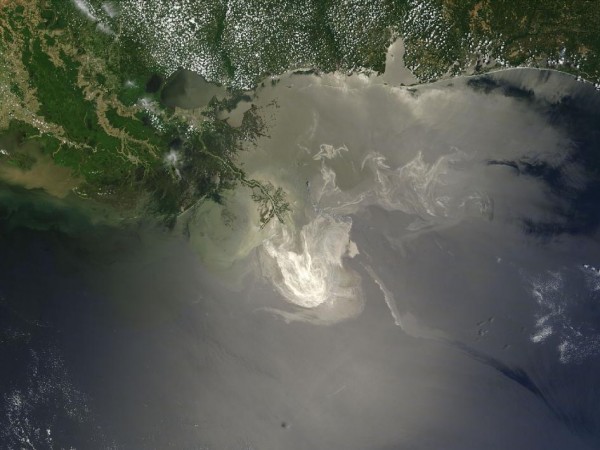By Ana Verayo, | January 26, 2016

Sunlight illuminated the lingering oil slick off the Mississippi Delta from the Deepwater Horizon oil spill on May 24, 2010.
Scientists have determined how much oil in the Gulf of Mexico is naturally occurring including how much was released during the Deepwater Horizon spill in 2010 where microbial life is now thriving from this oil.
Researchers from Florida State University created a map from this crucial data that reveals where the active natural oils leak from their locations. New findings from this new study reveals that 4.3 million barrels were released into the Gulf due to the oil spill, where as 160,000 to 600,000 barrels every year come from naturally escaping oil.
Like Us on Facebook
According to Oceanography professor Ian Macdonald of Florida State University, this information can provide crucial context for the Deepwater Horizon spill. Natural oil in the Gulf seeps over time yielding significant effects, however the spill was so concentrated that it caused a severe impact to the surrounding ecosystems and environment.
Included in the new findings is how dispersants eliminated 21 percent of the oil that came to the surface of the Gulf after the spill however, the remaining oil was spread out to more than 49 percent of the original area.
With this new data, scientists can already observe areas where oil already exists rather than spilling or spreading new oil into the area which also demonstrates how the Gulf adapted to its naturally occurring oil escapes.
Apart from this map, according to Ajit Subramaniam of the Lamont-Doherty Earth Observatory of Columbia University, this data set not only reveals natural oil locations but remarkable phytoplankton that are thriving in these natural oil seeps. Researchers discovered that phytoplankton concentrations are twice as rich compared to areas with no oil, just a few kilometers away.
Subramaniam says that this is now considered as new evidence that microbes in the Gulf are now adapted to survive oily environments or those with lower concentrations. This new discovery also proves that these particular phytoplankton are not affected by low oil concentrations, which is now helping them to survive and even thrive. However, this still does not mean that prolonged exposure to oil concentrations is safe for phytoplankton.
These new studies are published in Nature Geoscience and the Journal of Geophysical Research Oceans.
-
Use of Coronavirus Pandemic Drones Raises Privacy Concerns: Drones Spread Fear, Local Officials Say

-
Coronavirus Hampers The Delivery Of Lockheed Martin F-35 Stealth Fighters For 2020

-
Instagram Speeds Up Plans to Add Account Memorialization Feature Due to COVID-19 Deaths

-
NASA: Perseverance Plans to Bring 'Mars Rock' to Earth in 2031

-
600 Dead And 3,000 In The Hospital as Iranians Believed Drinking High-Concentrations of Alcohol Can Cure The Coronavirus

-
600 Dead And 3,000 In The Hospital as Iranians Believed Drinking High-Concentrations of Alcohol Can Cure The Coronavirus

-
COVID-19: Doctors, Nurses Use Virtual Reality to Learn New Skills in Treating Coronavirus Patients







